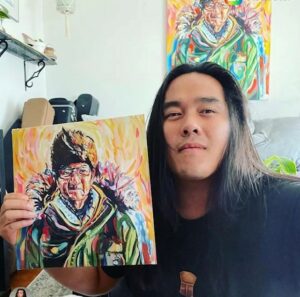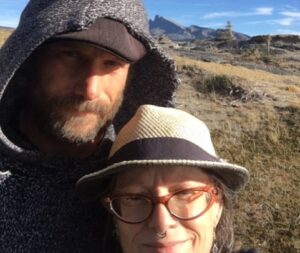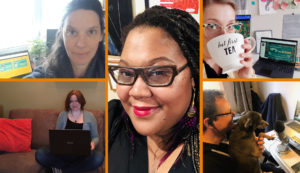
The painting that serves as the album cover for Aysanabee’s debut album, Watin, is strikingly beautiful. Can you tell us about the painting?
This piece was such an honour to paint. Watin, Aysanabee’s grandfather, is portrayed on a 36″ x 48″ gallery canvas. My work evolves as a wrestling match between loose, gestural paint and the restraint needed to pull it together into an emotionally charged subject. Within my portraits you can find loads of energy through brushstrokes using a highly saturated colour palette. Each painting consists of multiple layers with wait times in between. It starts off in Golden Acrylics, and sometimes spray paint, and the final touches are done in Winsor and Newton Oil Paint. I get messy using brushes, throwing paint, and using my fingers. My whole body and spirit are usually involved. It is a psychic dance with the energy of the person and the language of paint. When I paint a portrait of a family member, I fall into a deep state of really communicating to the spirit of the person, and I believe this is why they look so alive at the end of the painting. This painting took about two weeks to complete.
Aysanabee’s pandemic phone calls with his grandfather, who is a residential school survivor, inspired this album. What are your goals and hopes when working on a commissioned piece like this?
Painting is another vessel for communication. This only adds to the ongoing truth and recognition that needs to keep growing and spreading about Canada’s history. There is room for these stories to bleed into any medium, any style, and any voice. This is what art does. It grabs a viewer’s attention, it asks the viewer to pay attention, and it gives a radical moment for storytelling and discovery. Aysanabee’s music really has done so much for Canada and his listeners, and I feel so grateful that my art could stand alongside his powerful voice, story, and words.

Exploring the past as a way to mold it into a healing experience has always shaped my work. In 2016, in my graduating thesis year at Ontario College of Art & Design (OCAD) University, I painted about the life and wounds of my grandparents. While in the studio, I was overwhelmed by sadness and paralyzing emotion that flooded through my body as I connected to my grandparents’ trauma and coupled it with the alcoholism, depression, and anxiety that have found their way into myself and my immediate family’s life. I also know the roots of these issues go further. I began to paint my Indigenous grandmother and felt similar waves come through, of feeling trapped, alone, and raped. Her entire history was destroyed when she was married off to an Irish Settler fifty years older than her. Her name was erased and she was given a new one. I am an artist reflecting on the inner conflict that is this part of Canadian history. I am still uncovering this puzzle and researching through the Métis Nation of Ontario and my own painting practice. In 2021 my Indigenous grandmother came through in this large piece. She continues to act as a great guide in my life.
What are you working on now?
It is the holiday season, so I am busy finishing up commissions to be ready for Christmas! When I am not working on commissions, I tend to gravitate to doing landscape work, and my future goal is to continue exploring what it means to be Métis, how native is native, and how one sits with the internal dance and conflict of being both the oppressor and the oppressed. I believe my next series will ask these questions and will be a series of portraits showing confusion, conflict, and trying to fit in in one’s own identity and history. It makes sense that these stories take time to resurface. Shame dies when stories are told in safe places, and I think we are on the precipice of making this country a space like this, at least I hope.
CKUA has a huge music library. Would you choose a song for our listeners?
I love “Howling” from Aysanabee.






